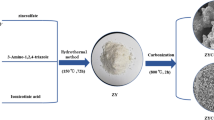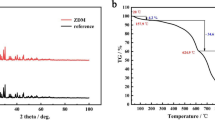Abstract
Metal–organic frameworks (MOFs) are network-like frameworks composed of transition metals and organic ligands containing oxygen or nitrogen. Because of its highly controllable composition and ordered porous structure, it has broad application prospects in the field of material synthesis. In this work, Zn4(PYDC)4(DMF)2∙3DMF (ZPD) was synthesized via a hydrothermal method. Self-doped nitrogen porous carbon ZPDC-T was then prepared by one-step carbonization. The results show that the self-doped nitrogen porous carbon ZPDC-850 has a micro/mesoporous structure with a specific surface area of 1520 m2 g−1 and a nitrogen content of 6.47%. When a current density is 1.0 A g−1, its specific capacitance is 265.1 F g−1. After 5000 times of constant current charging and discharging, the capacitance retention rate was 79.2%. Thus, self-doped nitrogen porous carbon ZPDC-850 exhibits excellent electrochemical properties and good cyclic stability. Therefore, the self-doped nitrogen porous carbon derived from MOFs can be a promising electrode material for supercapacitors.









Similar content being viewed by others
References
Zhou K, Wang H, Jiu J, Liu J, Yan H (2018) Polyaniline films with modified nanostructure for bifunctional flexible multicolor electrochromic and supercapacitor applications. Chem Eng J 345:290. https://doi.org/10.1016/j.cej.2018.03.175
Li K, Zhang W, Zhao Z, Zhao Z, Chen X, Kong L (2018) Facile preparation of novel hierarchically porous carbon at the molecular level for supercapacitor electrode application. NANO 13:08. https://doi.org/10.1142/S1793292018500911
Sun N, Li Y, Zhang Q, Hao X (2018) Giant energy-storage density and high efficiency achieved in (Bi0.5Na0.5)TiQ3-Bi(Ni0.5Zr0.5)O3 thick films with polar nanoregioons. J Mater Chem C 6:10693. https://doi.org/10.1039/C8TC03481H
Pan H, Ma J, Ma J, Zhang Q, Liu X, Guan B, Gu L, Zhang X, Zhang Y, Li L, Shen Y, Liu Y, Nan C (2018) Giant energy density and high efficiency achieved in bismuth ferrite-based film capacitors via domain engineering. Nat Commun 9:1813. https://doi.org/10.1038/s41467-018-04189-6
Zhang S, Yin B, Wang Z, Gu D (2017) A low-cost wearable yarn supercapacitor constructed by a highly bended polyester fiber electrode and flexible film. J Mater Chem A 5:15144. https://doi.org/10.1039/C7TA03697C
Balamurugan J, Nguyen TT, Aravindan V, Kim NH, Lee JH (2018) Flexible solid-state asymmetric supercapacitors based on nitrogen-doped graphene encapsulated ternary metal-nitrides with ultralong cycle life. Adv Funct Mater 28(44):1804663. https://doi.org/10.1002/adfm.201804663
Yin B, Wang Z, Zhang S, Liu C, Ren Q, Ke K (2016) In situ growth of free-standing all metal oxide asymmetric supercapacitor. ACS Appl Mater Interfaces 8:26019. https://doi.org/10.1021/acsami.6b08037
Liu L, Xie ZH, Deng QF, Hou XX, Yuan ZY (2017) One-pot carbonization enrichment of nitrogen in microporous carbon spheres for efficient CO2 capture. J Mater Chem A 5:418. https://doi.org/10.1039/C6TA09782K
Perazzolo V, Gra˛dzka E, Durante C, Pilot R, Vicentini N, Rizzi GA, Granozzi G, Gennaro A (2016) Chemical and electrochemical stability of nitrogen and sulphur doped mesoporous carbons. Electrochim Acta 197:251. https://doi.org/10.1016/j.electacta.2016.02.025
Wang C, Liu T, Nori-based N (2017) O, S, Cl co-doped carbon materials by chemical activation of ZnCl2 for supercapacitor. J Alloy Compd 696:42. https://doi.org/10.1016/j.jallcom.2016.11.206
Liu D, Zeng C, Qu D, Tang H, Li Y, Su BL, Qu D (2016) Highly efficient synthesis of ordered nitrogen-doped mesoporous carbons with tunable properties and its application in high performance supercapacitors. J Power Sources 321:143. https://doi.org/10.1016/j.jpowsour.2016.04.129
Chen X, Chen C, Zhang Z, Xie D (2013) Gelatin-derived nitrogen-doped porous carbon via a dual-template carbonization method for high performance supercapacitors. J Mater Chem A 1:10903. https://doi.org/10.1039/C3TA12328F
Wang H, Zhang C, Liu Z, Wang L, Han P, Xu H, Zhang K, Dong S, Yao J, Cui G (2011) Nitrogen-doped graphene nanosheets with excellent lithium storage properties. J Mater Chem 21:5430. https://doi.org/10.1039/C1JM00049G
Wei T, Wei X, Gao Y, Li H (2015) Large scale production of biomass-derived nitrogen-doped porous carbon materials for supercapacitors. Electrochim Acta 169:186. https://doi.org/10.1016/j.electacta.2015.04.082
Liu JJ, Deng YF, Li XH, Wang LF (2015) Promising nitrogen-rich porous carbons derived from one-step calcium chloride activation of biomass-based waste for high performance supercapacitors. ACS Sustain Chem Eng 4:177. https://doi.org/10.1021/acssuschemeng.5b00926
Ma G, Yang Q, Sun K, Peng H, Ran F, Zhao X, Lei Z (2015) Nitrogen-doped porous carbon derived from biomass waste for high-performance supercapacitor. Bioresour Technol 197:137. https://doi.org/10.1016/j.biortech.2015.07.100
Guo R, Li J, Jia Y, Xin F, Sun J, Dang L, Liu Z, Lei Z (2019) Nitrogen-doped carbon sheets coated on CoNiO2@textile carbon as bifunctional electrodes for asymmetric supercapacitors. J Mater Chem A 7:4165. https://doi.org/10.1039/C9TA00014C
Jin H, Feng X, Li J, Li M, Xia YZ, Yuan Y, Yang C, Dai B, Lin Z, Wang J, Wang S, Lu J (2019) Heteroatom-doped porous carbon materials with unprecedented high volumetric capacitive performance. Angew Chem 58:2397. https://doi.org/10.1002/anie.201813686
Liu D, Yu S, Shen YL, Chen H, Shen ZH, Zhao SY, Yu YM, Bao BF (2015) Polyaniline coated boron doped biomass derived porous carbon composites for supercapacitor electrode materials. Ind Eng Chem Res 54:12570. https://doi.org/10.1021/acs.iecr.5b02507
Hu Z, Li S, Cheng P, Yu W, Li R, Shao X, Lin W, Yuan D (2016) N, P-co-doped carbon nanowires prepared from bacterial cellulose for supercapacitor. J Mater Sci 51:2627. https://doi.org/10.1007/s1085
Dou S, Huang X, Ma Z, Wu J, Wang S (2015) A simple approach to the synthesis of BCN graphene with high capacitance. Nanotechnology 26:045402. https://doi.org/10.1088/0957-4484/26/4/045402
Xiao S, Pan D, Liang R, Dai WR, Zhang Q, Zhang G, Su C, Li HX, Chen W (2018) Bimetal MOF derived mesocrystal ZnCo2O4, on rGO with High performance in visible-light photocatalytic NO oxidization. Appl Catal B: Environ 236:304. https://doi.org/10.1016/j.apcatb.2018.05.033
Sun W, Cai C, Tang X, Lv L, Wang Y (2018) Carbon coated mixed-metal selenide microrod: bimetal-organic-framework derivation approach and applications for lithium-ion batteries. Chem Eng J 351:169. https://doi.org/10.1016/j.cej.2018.06.093
Guo B, Yang Y, Hu Z, An Y, Zhang Q, Yang X, Wang X, Wu H (2017) Redox-active organic molecules functionalized nitrogen-doped porous carbon derived from metal-organic framework as electrode materials for supercapacitor. Electrochim Acta 223:74. https://doi.org/10.1016/j.electacta.2016.12.012
Tong Y, Ji D, Wang P, Zhou H, Akhtar K, Shen X, Zhang J, Yuan A (2017) Nitrogen-doped carbon composites derived from 7,7,8,8-tetracyano-quinodimethane-based metal–organic frameworks for supercapacitors and lithium-ion batteries. RSC Adv 7:25182. https://doi.org/10.1039/C7RA02543B
Bo L, Hiroshi S, Jiang HL, Zhang XB, Xu Q (2010) Metal-organic framework (MOF) as a template for syntheses of nanoporous carbons as electrode materials for supercapacitor. Carbon 48:456. https://doi.org/10.1016/j.carbon.2009.09.061
Jeon JW, Sharma R, Meduri P, Arey BW, Schaef HT, Lutkenhaus JL, Lemmon JP, Thallapally PK, Nandasiri MI, McGrail BP, Nune SK (2014) In situ one-step synthesis of hierarchical nitrogen-doped porous carbon for high-performance supercapacitors. ACS Appl Mater Interfaces 6:7214. https://doi.org/10.1021/am500339x
Jiang H, Liu B, Lan Y, Kuratani K, Akita T, Shioyama H, Zong F, Xu Q (2011) From metal–organic framework to nanoporous carbon: toward a very high surface area and hydrogen uptake. J Am Chem Soc 133:11854. https://doi.org/10.1021/ja203184k
Ahrenholtz SR, Landaverde-Alvarado C, Whiting M, Lin S, Slebodnick C, Marand E, Morris AJ (2015) Thermodynamic study of CO2 sorption by polymorphic microporous MOFs with open Zn(ii) coordination sites. Inorg Chem 4328:54. https://doi.org/10.1021/ic503047y
Liu F, Xiong W, Liu J, Cheng Q, Cheng G, Shi L, Zhang Y (2018) Novel amino-functionalized carbon material derived from metal organic framework: a characteristic adsorbent for U(VI) removal from aqueous environment. Colloids Surf A 556:72. https://doi.org/10.1016/j.colsurfa.2018.08.009
Hanappi MFYM, Deraman M, Suleman M, Nor NSM, Sazali NES, Hamdan E, Tajuddin NSM, Basri NH, Jasni MRM, Othman MAR (2017) Influence of aqueous KOH and H2SO4 electrolytes ionic parameters on the performance of carbon-based supercapacitor electrodes. Funct Mater Lett 10:1. https://doi.org/10.1142/S1793604717500138
Huang S, Zhang J, Li P, Wang W, Feng H, Luo HM (2018) Preparation of metal-organic framework-derived porous carbon and study of its supercapacitive performance in potassium citrate electroyte. Electrochim Acta 284:328. https://doi.org/10.1016/j.electacta.2018.07.102
Liu X, Zhou W, Yang L, Zhang Z, Ke Y, Chen S (2015) Nitrogen and sulfur co-doped porous carbon derived from human hair as highly efficient metal-free electrocatalysts for hydrogen evolution reactions. J Mater Chem A 3:8840. https://doi.org/10.1039/C5TA01209K
Lei P, Li XX, Wang YX, Liu JL, Tian W, Ning H, Wu MB (2018) 3D interconnected honeycomb-like and high rate performance porous carbons from petroleum asphalt for supercapacitors. Appl Surf Sci 444:739. https://doi.org/10.1016/j.apsusc.2018.03.122
Zhang Y, Zhu J, Ren H, Bi Y, Zhang L (2017) Facile synthesis of nitrogen-doped graphene aerogels functionalized with chitosan for supercapacitors with excellent electrochemical performance. Chin Chem Lett 28:935. https://doi.org/10.1016/j.cclet.2017.01.023
Tian J, Zhang H, Liu Z, Qin G, Li Z (2018) One-step synthesis of 3D sulfur-doped porous carbon with multilevel pore structure for high-rate supercapacitors. Int J Hydrogen Energy 43:1596. https://doi.org/10.1016/j.ijhydene.2017.11.091
Zheng K, Li Y, Zhu M, Yu X, Zhang M, Shi L, Chen J (2017) The porous carbon derived from water hyacinth with well-designed hierarchical structure for supercapacitors. J Power Sources 366:270. https://doi.org/10.1016/j.jpowsour.2017.09.034
Hu LT, Hou JX, Ying M, Li HQ, Zhai TY (2016) Multi-heteroatom self-doped porous carbon derived from swim bladders for large capacitance supercapacitors. J Mater Chem A 4:15006. https://doi.org/10.1039/C6TA06337C
Acknowledgements
This work is partially supported by the fund of National Nature Science Foundation of China (Nos. 21667017 and 21666018) and Gansu Province University Fundamental Research Funds.
Author information
Authors and Affiliations
Corresponding author
Additional information
Publisher's Note
Springer Nature remains neutral with regard to jurisdictional claims in published maps and institutional affiliations.
Rights and permissions
About this article
Cite this article
Zhang, D., Zhang, C., Wang, Q. et al. Preparation and electrochemical properties of self-doped nitrogen porous carbon derived from Zn-MOFs. Carbon Lett. 30, 315–324 (2020). https://doi.org/10.1007/s42823-019-00100-5
Received:
Revised:
Accepted:
Published:
Issue Date:
DOI: https://doi.org/10.1007/s42823-019-00100-5




